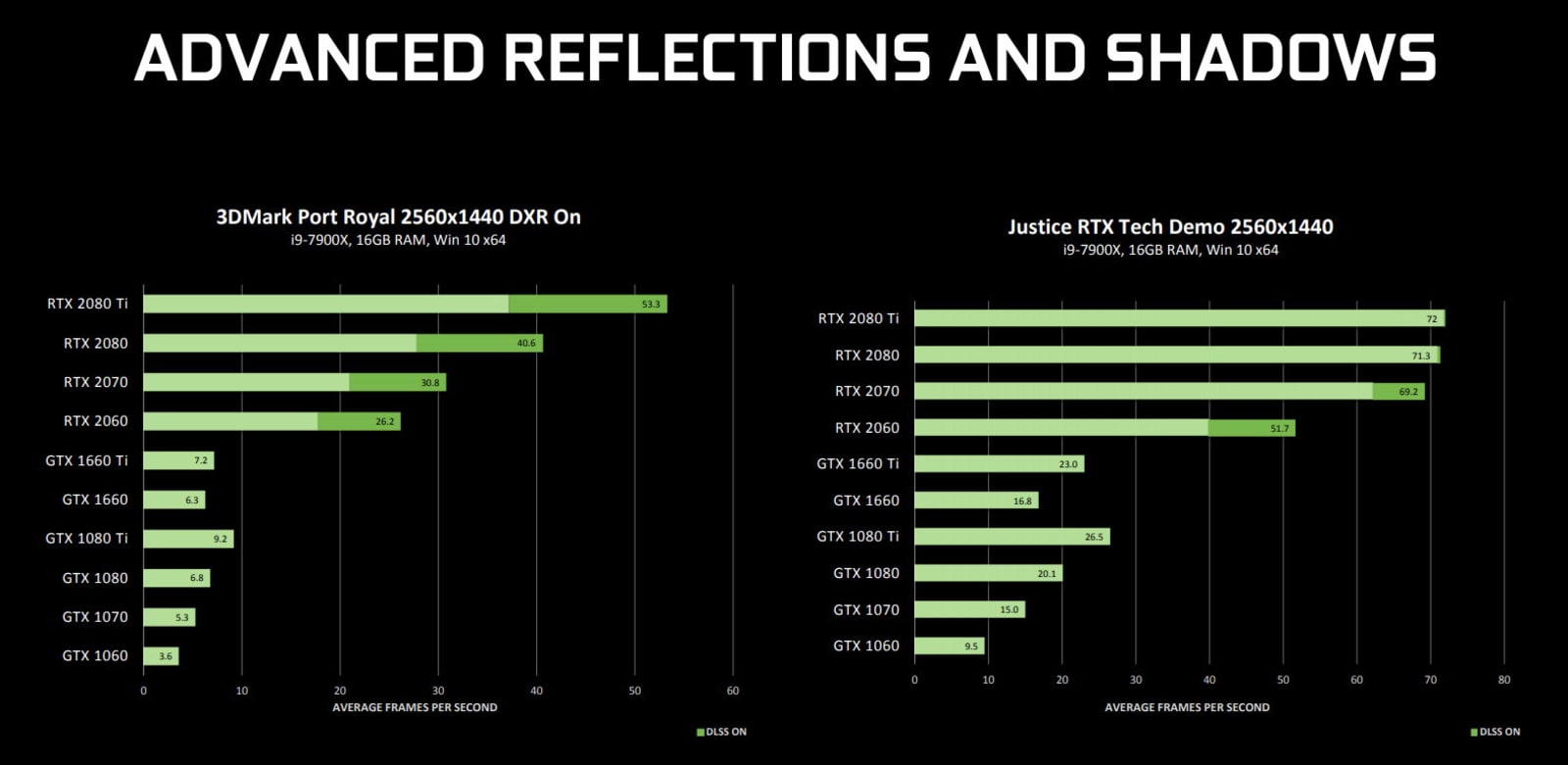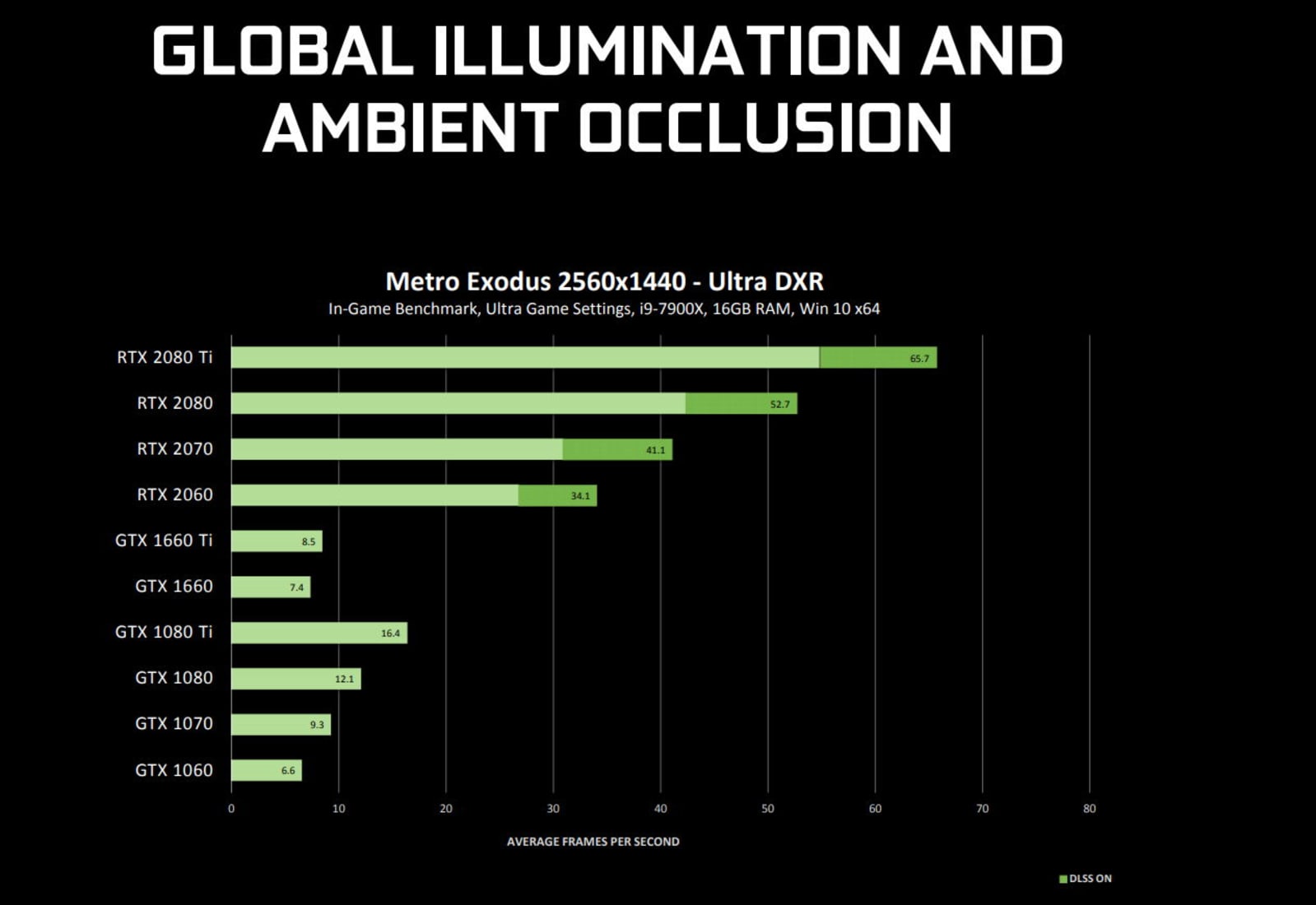| Followers | 679 |
| Posts | 140700 |
| Boards Moderated | 37 |
| Alias Born | 03/10/2004 |
Friday, April 12, 2019 4:16:33 PM
By: Engadget | April 11, 2019
Reflections and shadows will be six times slower on some games.
NVIDIA recently announced that ray-tracing is coming to older Pascal GPUs, and now it has detailed how well -- or not well, rather -- it will actually work. If you're happy with basic effects, the news isn't too bad. The RTX 2080 Ti will outperform its 1080 Ti counterpart by just over double for reflections, in line with what you'd expect for a next-gen card. However, for stuff that really adds realism, like advanced shadows, global illumination and ambient occlusion, the RTX 2080 Ti outperforms the 1080 Ti by up to a factor of six.
To cite some specific examples, Port Royal will run on the RTX 2080 Ti at 53.3 fps at 2,560 x 1,440 with advanced reflections and shadows, along with DLSS anti-aliasing, turned on. The GTX 1080, on the other hand, will run at just 9.2 fps with those features enabled and won't give you any DLSS at all. That effectively makes the feature useless on those cards for that game. With basic reflections on Battlefield V, on the other hand, you'll see 30 fps on the 1080 Ti compared to 68.3 on the 2080 Ti.

Meanwhile, if you want ambient occlusion, which delivers subtle shadow and lighting effects, you'll be able to run that at 59.5 fps on the RTX 2080 Ti (on an RTX tech demo), 47.6 fps on the RTX 2080, 33.7 fps on the RTX 2070 and 31.1 fps on the RTX 2060. Meanwhile, the GTX 1080 Ti will only hit an unusable 9.4 fps, or 6.8 fps, 5.2 fps, and 3.5 fps on the GTX 1080, 1070 and 1060 respectively. Other realism-oriented features, like global illumination, feature similar performance drops on the older Pascal cards.
What this means is that despite NVIDIA's promise to offer ray-tracing on Pascal, the features are largely unworkable for real-life gaming. This isn't terribly surprising, the newer RTX cards feature banks of chips dedicated solely to boosting RTX and DLSS anti-aliasing. Also, NVIDIA already said that performance would be poor, but now can see exactly how much they accelerate those effects compared to the older cards.
So what good will the feature do you then? Well, you can always try out your favorite game and turn ray-tracing on and off to see whether you think it's worth using. That's certainly better than not having the effect at all. Mostly, it appears as if NVIDIA wanted to tamp down expectations before the features are released in the wild -- and looking at the numbers, it has succeeded in that.

Read Full Story »»»
• DiscoverGold
Information posted to this board is not meant to suggest any specific action, but to point out the technical signs that can help our readers make their own specific decisions. Your Due Dilegence is a must!
• DiscoverGold
Recent NVDA News
- Traders May Make Another Attempt At Bargain Hunting • IH Market News • 04/18/2024 01:14:37 PM
- Apple to Invest $250 Million in Singapore Expansion, Oracle Commits $8 Billion to Japan Infrastructure, and More News • IH Market News • 04/18/2024 11:11:52 AM
- United Shares Surge 5.3% in Q1 2024 Earnings Beat; Take-Two Cuts 5% of Workforce, and More News • IH Market News • 04/17/2024 10:57:39 AM
- Delta Generates US$37 Million Profit in Q1, Google and Intel Unveil Cutting-Edge AI Chips, and More News • IH Market News • 04/10/2024 11:13:48 AM
- U.S. Stocks May Move Back To The Upside In Early Trading • IH Market News • 04/05/2024 01:10:21 PM
- Apple Terminates 614 Employees, Disney Unveils June Crackdown on Password Sharing, and More Updates • IH Market News • 04/05/2024 11:38:57 AM
- U.S. Stocks Close Sharply Lower Following Late-Day Sell-Off • IH Market News • 04/04/2024 08:34:37 PM
- Cal-Maine Surges on Strong Quarterly Performance, Taiwan Earthquake Disrupts Tech Supply Chain, and More • IH Market News • 04/03/2024 11:12:20 AM
- GameStop Shares Tumble 20% in Pre-Market Trading Amid Revenue Decline, Direct Digital Plummets 42%, and More News • IH Market News • 03/27/2024 10:54:47 AM
- Tech Sector Weakness May Weigh On Wall Street • IH Market News • 03/25/2024 01:26:54 PM
- U.S. Stocks Close Mixed On The Day But Sharply Higher For The Week • IH Market News • 03/22/2024 08:40:00 PM
- Looming Fed Announcement May Lead To Choppy Trading On Wall Street • IH Market News • 03/20/2024 01:16:55 PM
- U.S. Index Futures Trade Sideways Amid Anticipation of Fed’s Policy Update; Oil Prices Dip • IH Market News • 03/20/2024 11:17:32 AM
- JPMorgan boosts dividends, Chipotle unveils 50:1 stock split, and Latest News • IH Market News • 03/20/2024 11:15:48 AM
- U.S. Stocks Show Notable Turnaround Amid Rebound By Nvidia • IH Market News • 03/19/2024 08:35:13 PM
- Futures Pointing To Initial Pullback On Wall Street • IH Market News • 03/19/2024 01:22:58 PM
- Unilever Initiates Ice Cream Division Spin-Off and Announces Job Cuts; Berkshire Ramps Up Share Buyback Efforts, and More • IH Market News • 03/19/2024 11:33:10 AM
- US Index Futures Decline Ahead of Federal Reserve Meeting, Oil Prices Retreat • IH Market News • 03/19/2024 11:27:29 AM
- Nvidia Unveils Blackwell: The Next-Gen AI Architecture Powering the Future of Computing • IH Market News • 03/19/2024 10:35:39 AM
- NVIDIA Digital Human Technologies Bring AI Characters to Life • GlobeNewswire Inc. • 03/18/2024 10:01:38 PM
- NVIDIA Powers Japan’s ABCI-Q Supercomputer for Quantum Research • GlobeNewswire Inc. • 03/18/2024 10:00:56 PM
- NVIDIA Unveils 6G Research Cloud Platform to Advance Wireless Communications With AI • GlobeNewswire Inc. • 03/18/2024 10:00:28 PM
- Google Cloud and NVIDIA Expand Partnership to Scale AI Development • PR Newswire (US) • 03/18/2024 10:00:00 PM
- SAP and NVIDIA to Accelerate Generative AI Adoption Across Enterprise Applications Powering Global Industries • PR Newswire (US) • 03/18/2024 10:00:00 PM
- Oracle and NVIDIA to Deliver Sovereign AI Worldwide • PR Newswire (US) • 03/18/2024 10:00:00 PM
Coinllectibles' Subsidiary, Grand Town Development Limited, Acquires Rare Song Dynasty Ceramics Worth Over USD28million • COSG • Apr 18, 2024 8:03 AM
ILUS Provides Form 10-K Filing Update • ILUS • Apr 17, 2024 9:54 AM
Glucotrack Announces Expansion of Its Continuous Glucose Monitoring Technology to Epidural Glucose Monitoring • GCTK • Apr 17, 2024 8:00 AM
Maybacks Global Entertainment To Fire Up 24 New Stations in Louisiana • AHRO • Apr 16, 2024 1:30 PM
Cannabix Technologies Begins Certification of Contactless Alcohol Breathalyzer, Re-Brands product series to Breath Logix • BLOZF • Apr 16, 2024 8:52 AM
Kona Gold Beverages, Inc. Acquires Surge Distribution LLC from Loud Beverage Group, Inc. (LBEV) • KGKG • Apr 16, 2024 8:30 AM









